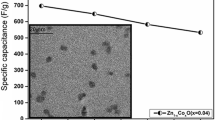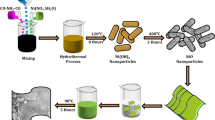Abstract
In the design of supercapacitor electrode materials, a large active surface area for energy storage, reduced ion diffusion pathway, low charge conduction resistance, and mechanical reliability in relation to energy density during charging and discharging are fundamental requirements. In this work, layered heterostructure materials were fabricated by a chemical route and achieved extraordinary results, obtaining supercapacitors with good electrochemical compatibility. The electron transfer in the layered structure significantly enhanced the electropotential and current photocurrent for the effective separation of electron–hole pairs. The as-prepared fluorine-doped tin oxide substrate/titanium dioxide/cadmium sulfide quantum dots/polyaniline (FTO/TiO2/CdS-QDs/PANI) demonstrates outstanding supercapacitive performance (1118.5 Fg−1 at 5 Ag−1) and exceptional rate efficiency (800.7 Fg−1 at 20 A g−1) with the incorporation of CdS-QDs and PANI layer. The fabricated supercapacitor device provides optimal energy density of 67.4 Wh kg−1 at power density of 1544.3 W kg−1. The significant results were associated with the TiO2 nanostructure, which can promote more rapid ion diffusion, and CdS-QDs that can produce high ion diffusion in the materials while improving the stability of the electrodes. Furthermore, the fabricated asymmetric supercapacitor exhibits good cyclic stability, with 70% capacitive retention after 5000 cycles. The present research work reveals an effective new way to assemble layered electrodes for supercapacitor applications.







Similar content being viewed by others
Data Availability
The data sets produced during or analyzed during the current study are available from the corresponding author on reasonable request.
References
C. Wu, Y. Zhu, C. Guan, C. Jia, W. Qin, X. Wang, and K. Zhang, Mesoporous aluminium manganese cobalt oxide with pentahedron structures for energy storage devices. J. Mater. Chem. A 7, 18417–18427 (2019).
J. Hao, B. Li, X. Li, X. Zeng, S. Zhang, F. Yang, S. Liu, D. Li, C. Wu, and Z. Guo, An in-depth study of Zn metal surface chemistry for advanced aqueous Zn-ion batteries. Adv. Mater. 32, 2003021 (2020).
J. Hao, X. Li, X. Zeng, D. Li, J. Mao, and Z. Guo, Deeply understanding the Zn anode behaviour and corresponding improvement strategies in different aqueous Zn-based batteries. Energy Environ. Sci. 13, 3917–3949 (2020).
L. Zeng, X. Lou, J. Zhang, C. Wu, J. Liu, and C. Jia, Carbonaceous mudstone and lignin-derived activated carbon and its application for supercapacitor electrode. Surf. Coat. Technol. 357, 580–586 (2019).
X. Yang, J. Mao, H. Niu, Q. Wang, K. Zhu, K. Ye, G. Wang, D. Cao, and J. Yan, NiS2/MoS2 mixed phases with abundant active edge sites induced by sulfidation and graphene introduction towards high-rate supercapacitors. Chem. Eng. J. 406, 126713 (2021).
F.N.I. Sari and J.M. Ting, MoS2/MoOx-nanostructure-decorated activated carbon cloth for enhanced supercapacitor performance. Chem. Sus. Chem. 11, 897–906 (2018).
X. Lu, G. Wang, T. Zhai, M. Yu, J. Gan, Y. Tong, and Y. Li, Hydrogenated TiO2 nanotube arrays for supercapacitors. Nano Lett. 12, 1690–1696 (2012).
H. Zhou and Y. Zhang, Electrochemically self-doped TiO2 nanotube arrays for supercapacitors. J. Phys. Chem. C 118, 5626–5636 (2014).
K.T. Kubra, R. Hafeez, G. Ali, H. Ahmad, A. Butt, A. Salman, R. Sharif, M. Sultana, and M. Bashir, Electrochemical investigation of a novel quaternary composite based on dichalcogenides, reduced graphene oxide, and polyaniline as a high-performance electrode for hybrid supercapacitor applications. J. Alloy. Compd. 909, 164854 (2022).
H. Wu, D. Li, X. Zhu, C. Yang, D. Liu, X. Chen, Y. Song, and L. Lu, High-performance and renewable supercapacitors based on TiO2 nanotube array electrodes treated by an electrochemical doping approach. Electrochim. Acta 116, 129–136 (2014).
B.S. Rao, B.R. Kumar, V.R. Reddy, and T.S. Rao, Preparation and characterization of CdS nanoparticles by chemical co-precipitation technique. Chalcogenide Lett. 8, 177–185 (2011).
H. Tang, J. Wang, H. Yin, H. Zhao, D. Wang, and Z. Tang, Growth of polypyrrole ultrathin films on MoS2 monolayers as high-performance supercapacitor electrodes. Adv. Mater. 27, 1117–1123 (2015).
F. Beguin, V. Presser, A. Balducci, and E. Frackowiak, Carbons and electrolytes for advanced supercapacitors. Adv. Mater. 26, 2219–2251 (2014).
K.L. Van Aken, M. Beidaghi, and Y. Gogotsi, Formulation of ionic-liquid electrolyte to expand the voltage window of supercapacitors. Angew. Chem. 127, 4888–4891 (2015).
C. Zhong, Y. Deng, W. Hu, J. Qiao, L. Zhang, and J. Zhang, A review of electrolyte materials and compositions for electrochemical supercapacitors. Chem. Soc. Rev. 44, 7484–7539 (2015).
F. Liu, S. Luo, D. Liu, W. Chen, Y. Huang, L. Dong, and L. Wang, Facile processing of free-standing polyaniline/SWCNT film as an integrated electrode for flexible supercapacitor application. Appl. Mater. Interf. ACS. 9, 33791–33801 (2017).
S.Y. Chen, X.Y. Zhang, B. Liu, H. Shi, F. Chen, C.L. Hu, and J. Chen, Characterisations of carbon-fenced conductive silver nanowires-supported hierarchical polyaniline nanowires. Electrochim. Acta 292, 435–445 (2018).
S. Tian, C. Zhao, P. Nie, H. Wang, X. Xue, L. Lin, and L. Chang, Electrochemical deposition enables freestanding CoNi layered double hydroxide/MnOX electrode with enhanced electrochemical properties for asymmetric supercapacitors. Energy Technol. 7, 1900680 (2019).
R. Kumuthini, R. Ramachandran, H.A. Therese, and F. Wang, Electrochemical properties of electrospun MoS2@C nanofiber as electrode material for high-performance supercapacitor application. J. Alloy. Compd. 705, 624–630 (2017).
G. Kun, Strongly intrinsic anharmonicity in the low-frequency Raman mode in nanocrystalline anatase TiO. Physica B 398, 33–37 (2007).
P. Liu, J. Yan, X. Gao, Y. Huang, and Y. Zhang, Construction of layer-by-layer sandwiched graphene/polyaniline nanorods/carbon nanotubes heterostructures for high performance supercapacitors. Electrochim. Acta 272, 77–87 (2018).
W. Luo, C. Zhang, Y. Cui, S. Yan, Q. Qin, and Z. Jing, One-step extended strategy for the ionic liquid-assisted synthesis of Ni3S4–MoS2 heterojunction electrodes for supercapacitors. J Mater ChemA. 5, 11278–11285 (2017).
S. Chen, B. Liu, X. Zhang, F. Chen, H. Shi, C. Hu, and J. Chen, Growth of polyaniline on TiO2 tetragonal prism arrays as electrode materials for supercapacitor. Electrochim. Acta 300, 373–379 (2019).
K. Yang, Z. Luo, D. Shu, F. Yi, Z. Zhu, and A. Gao, Design of few-layered 1T-MoS2 by supramolecular-assisted assembly with N-doped carbon quantum dots for supercapacitor. J. Electroanalytical Chem. 908, 116093 (2022).
A. Orendorz, A. Brodyanski, J. Losch, L.H. Bai, Z.H. Chen, Y.K. Le, and C.H. Ziegler, Gnaser phase transformation and particle growth in nanocrystalline anatase TiO2 films analyzed by x-ray diffraction and raman spectroscopy. Surf. Sci. 601, 4390–4394 (2007).
G. Cheng, M.S. Akhtar, O.B. Yang, and F.J. Stadler, Structure modification of anatase TiO2 nanomaterials-based photoanodes for efficient dye-sensitized solar cells. Electrochim. Acta 113, 527–535 (2013).
G.M. Nascimento and M.A. Temperini, Studies on the resonance Raman spectra of polyaniline obtained with near-IR excitation. J Raman Spect. 39, 772–778 (2008).
K. Yang, A. Gao, H. Wu, F. Yi, D. Shu, X. Li, and L. Xie, Layered molybdenum disulfide coated carbon hollow spheres synthesized through supramolecular self-assembly applied to supercapacitors. Int. J. Energy Res. 44, 7082–7092 (2020).
J. Zhou, M. Guo, L. Wang, Y. Ding, Z. Zhang, Y. Tang, C. Liu, and S. Luo, 1T-MoS2 nanosheets confined among TiO2 nanotube arrays for high performance supercapacitor. Chem. Eng. J. 366, 163–171 (2019).
D. Qu, M. Zheng, P. Du, Y. Zhou, L. Zhang, D. Li, H. Tan, Z. Zhao, Z. Xie, and Z. Sun, Highly luminescent S, N co-doped graphene quantum dots with broad visible absorption bands for visible light photocatalysts. Nanoscale 5, 12272–12277 (2013).
W. Kong, C. Lu, W. Zhang, J. Pu, and Z. Wang, Homogeneous core–shell NiCo2S4 nanostructures supported on nickel foam for supercapacitors. J. Mater. Chem. A 3, 12452–12460 (2015).
B. Wang, R. Hu, J. Zhang, Z. Huang, H. Qiao, L. Gong, and X. Qi, 2D/2D SnS2/MoS2 layered heterojunction for enhanced supercapacitor performance. J. Am. Ceram. Soc. 103, 1088–1096 (2020).
Acknowledgments
The authors would like to extend their sincere appreciation to the Researcher supporting program at King Saud University, Riyadh, for funding this work under the project number (RSPD2023R699).
Author information
Authors and Affiliations
Contributions
SMA: Conceptualization, Writing—review & editing, Supervision, Formal analysis, Writing—original draft.
Corresponding author
Ethics declarations
Conflict of interest
The author confirms that there is no conflict of interest or competing interests with regard to this work.
Ethical Approval
This article does not contain any studies involving animals performed by the author. In addition, this article does not contain any studies involving human participants performed by the author.
Additional information
Publisher's Note
Springer Nature remains neutral with regard to jurisdictional claims in published maps and institutional affiliations.
Rights and permissions
Springer Nature or its licensor (e.g. a society or other partner) holds exclusive rights to this article under a publishing agreement with the author(s) or other rightsholder(s); author self-archiving of the accepted manuscript version of this article is solely governed by the terms of such publishing agreement and applicable law.
About this article
Cite this article
Ali, S.M. An Approach for CdS-QD-Based Layered Heterostructure Electrodes for Supercapacitor Applications. J. Electron. Mater. 53, 207–216 (2024). https://doi.org/10.1007/s11664-023-10762-7
Received:
Accepted:
Published:
Issue Date:
DOI: https://doi.org/10.1007/s11664-023-10762-7




